Introduction
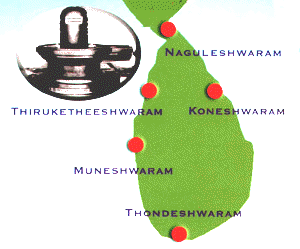 There
were temples, dedicated to the Supreme Lord Ishwaran, on all the four sides,
of ancient Ceylon. They safeguarded the little island from oceanic bed
upheavals, convulsions and other natural disasters that prevailed in the
region during the pre-historical eras. They were Thiruketheeshwaram and
Muneshwaram Temples in the West, Thondeshwaram in the South, Koneshwaram in
the East and Naguleshwaram in the North.
There
were temples, dedicated to the Supreme Lord Ishwaran, on all the four sides,
of ancient Ceylon. They safeguarded the little island from oceanic bed
upheavals, convulsions and other natural disasters that prevailed in the
region during the pre-historical eras. They were Thiruketheeshwaram and
Muneshwaram Temples in the West, Thondeshwaram in the South, Koneshwaram in
the East and Naguleshwaram in the North.
These five celebrated Ishwarams or Pancha Ishwaram Temples were important
landmarks of the country and had India's adoration. The erudite scholar and
historian, Dr.Paul E.Pieris declared in 1917, at a meeting of the Royal
Asiatic Society (Ceylon Branch), that:
"Long before the arrival of Vijaya there was in Lanka five recognised
Ishwarams of Shiva which claimed and received adoration of all India.
These were Thiruketheeshwaram which was near Mahatittha, Muneshwaram
dominating Salawatte and the pearl fishery, Thondeshwaram near Mantota,
ThiruKoneshwaram near the great Bay of Kottiyar and Naguleshwaram near
Kankesanturai " .
How each of these five Pancha Ishwaram Temples survived the ravages of
time and destruction by foreign invaders, is the subject of narration in the
following pages.

Thiruketheeshwaram
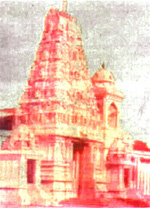
 Thiruketheeshwaram,
near Mannar, is the Sthalam where thousands gather on Shivarathri night for
veneration of Lord Shiva. They perform their sin dispelling ablutionary
theertham baths in the sacred waters of Pal Theertham, the following
morning.
Thiruketheeshwaram,
near Mannar, is the Sthalam where thousands gather on Shivarathri night for
veneration of Lord Shiva. They perform their sin dispelling ablutionary
theertham baths in the sacred waters of Pal Theertham, the following
morning.
The location became hallowed from the mythological era for it was here
that Kethu Bhagavan performed thapas and obtained the benign vision of Lord
Parameswara and Ambaldevi; hence the site became known as
"Thiru-Kethu-lshwaram".
Agasthiya Maha Munivar
It is said that the Sage Agasthiya Maha Munivar, in his pilgrimage to
Shiva Sthalams in the South, paid homage at Thiruketheeshwaram also, before
proceeding to Dakshana Kailash (Koneshwaram).
Matotta a great Sea Port
Matotta (or Matoddam), the celebrated city that Maha Thuwadda pounded
became a great Sea Port and marketing centre of world renown. Babylonians.
Egyptians,Greeks, Chinese and Japanese bartered their goods at Matotta.
Thiruketheeshwaram Temple received much support. The Pallava era, which
created a magnificent temple at Koneshwaram, created an upsurge of Hinduism
in the country, from about the 5th century. It was then that Saint
Thirugnana Sampanthar and later Saint Suntharar each offered a Pathikam of
Thevaram verses to the Lord of Thiruketheeshwaram. These are precious verses
that are recited by every Hindu, almost daily.
The Chola Power ruled over entire Ceylon for 72 years in the 10th
century; their activities were mostly at Polonnaruwa, their capital city and
in the Trincomalee Region. A temple with the name of Veera Rameswaram was
erected here during the regime of Sundara Pandiyan, in the 13th century.
The Decline of Mathoddam
With the silting up of the Gulf of Mannar by Manal Aar (Malwattu Oya),
and the discovery of the Mariner's Compass which made navigation in
mid-ocean possible, the fortunes of Matoddam as a sea port declined (and was
never regained). Finally, with the advent of the Portuguese in Mannar and
the consequent warfare, all Pujas terminated at Thiruketheeshwaram Temple in
1589. The Portuguese Governor was seen supervising the transport of the
temple stones for building the Mannar Fort.
Rebuilding temple at Thiruketheeshwaram
After a lapse of over four hundred years, Arumuga Navalar, who urged the
people to rebuild the temple, revived the subject. An effort was made during
the early years of the century and a small shrine was built in 1910. With
the restoration of the ancient Palavi Theertham in 1949, a major effort was
made and a proper temple was completed in 1976.
Theertha Kavady
Theertha Kavady is a special ritual here. To be permitted to perform
Linga Abishekam himself is the greatest aspiration of any pious Hindu. This
is possible only in Kasi and Thiruketheeshwaram. It is not simply taking
water from Palavi and pouring over the Maha Lingam. It is performed with
devotion and in keeping with the seven requirements laid down, saying "Let
us all gather to anoint Him who had been distressed and in that process wash
our sins away".
Effects of the Ethnic conflict
The Sri Lankan Army occupied the temple premises for a time but vacated
it later, when protests were made. All the buildings and the madams in the
temple area are said to have been demolished and the stones removed. Only
the temple building is said to survive, but without any fittings. (but see
also the
desecration of the Thiruketheeshwaram temple by the Sri Lanka armed forces)

Muneshwaram [see also
Munnicuvaram (Munnesvaram) Kovil: Its History, Ceremonies and Layout -
Professor A. Velupillai, 1995]
Origin
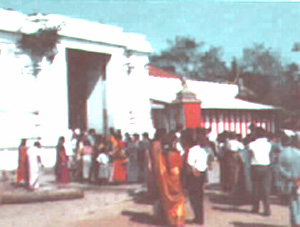 Muneshwaram
Temple is situated about a mile East of Chilaw, a town about 50 miles
North of Colombo. This Munna Nathar Shetram, housing Munnai
Natharsametha Vadivambikai Ambal, is of very ancient origin, said to
have been founded by Brahms for worship by Himself Vishnu Mahendran,
Munivars, sages and seers (Dakshana Kailasa Puranam ). The name Muneshwaram
is suggestive of it being an "Eshwaram" or Shivan Temple of the Munivars; as
mythology would have it, it is said to have been venerated by Rishi Munivars
in the ancient eras. Some claim a foremost place for it because of its name
with "Mun" in front.
Muneshwaram
Temple is situated about a mile East of Chilaw, a town about 50 miles
North of Colombo. This Munna Nathar Shetram, housing Munnai
Natharsametha Vadivambikai Ambal, is of very ancient origin, said to
have been founded by Brahms for worship by Himself Vishnu Mahendran,
Munivars, sages and seers (Dakshana Kailasa Puranam ). The name Muneshwaram
is suggestive of it being an "Eshwaram" or Shivan Temple of the Munivars; as
mythology would have it, it is said to have been venerated by Rishi Munivars
in the ancient eras. Some claim a foremost place for it because of its name
with "Mun" in front.
Rama Bhagavans sojourn
Sri Rama Bhagavan found solace here when he was returning home after the
Ramayana episode, with a heavy conscience thinking of the many deaths in the
battle.
Here he experienced relief from the "Brahma Sakthy" that had worried him;
so he, accompanied by Sita Devi stopped here and performed puias and other
observances.
It is also one of the temples renovated by Prince Vijaya (483-445 B.C.)
after being crowned King of Lanka, for the well being of his subjects. It
was improved and maintained by the Cholas during their occupation of the
Island.
Demolition
The temple was well endowed and gifted with several villages and paddy
lands. The reputed wealth of the temple attracted the greed of the
Portuguese invaders who looted it and finally destroyed it in 1578.
Resuscitation
However, about 200 years later a fisherman's hook got entangled in
something heavy. To his amazement he found that it was a Devi Vigrakam. He
handed it over to a Brahmin priest, who cherished it performing pujas daily,
but in secret. However, it soon leaked out that the priest was in possession
of what was ill begotten and was taken to court. To testify that his story
was genuine he was ordered to identify this vigrakam, in Court, from among
several similar others. The humble priest was thoroughly scared.
He feared imprisonment, if he failed. He entrusted himself entirely to
the Grace of Ambal Devi and invoked her succour. That night, Devi told him,
in a revelation, not to be afraid, but to watch carefully for her Nod as he
walked past her in the identification parade. Elated thus with Devi's Grace,
the priest braved the assembly the following day. At the parade, passing
others, when he came near his Ambal Vigrakam, a flower crowning that
Vigrakam dropped at his feet. Realising that it was the "Nod" he awaited, he
selected the correct Vigrakam. The priest was discharged and was also
entrusted with his Ambal Vigrakam. There was much rejoicing in the village;
everyone spoke of Vadivambikai Ambal's Grace aiding the priest. It was a
miracle. The Devi Vigrakam was taken in procession, and handed over to be
installed at a prominent place in the temple.
The temple was restored for worship in 1753. Later it was renovated in
1875, by efforts made by Brahma Sri Cumaraswamy Kurukkal; it was improved in
1919 and further in 1963 with support of Hindus, all over Ceylon. It was
renovated recently and a Gopuram was also constructed.
Around the Temple
The Shiva Lingam presides majestically in the sanctum. In the Maha
Mandapam is found Devi, here presiding as Vadivambikai Ambal and facing
South. Also facing South is the ad joining, less elaborate shrine for
Sundara Nadarajah Murthi. A small shrine for Sanmuga Swami is found next to
it. The Pidshanda vigrakam found at Muneshwaram temple is of striking
interest and is over five feet in height, almost human in size. It depicts a
handsomely built figure going out on a hunting expedition or returning
therefrom, carefree and accompanied by a dog and carrying the spoils of his
expedition. This vigrakam is taken out in procession, on a particular day of
the Annual Mahotsava festivals. The portrait of the Grand Old Man of
Muneshwaram, Brahma Sri Cumaraswamy Kurukkal, is seen on the centre pillar.
In the Western Praharam is the Lingotpava Murthi. Lord Shiva is seen
emerging from a Shiva Lingam to the consternation of Lord Brahma and Maha
Vishnu, who are seen standing aghast, at the bottom. This assembly depicts a
Puranic episode when Brahma and Vishnu were unable to locate the top and
bottom of a column of light that was Shiva.
Annual Festival
The annual festival at this temple lasts for twenty-seven days
terminating with the watercutting ceremony, on the full moon day in the
month of Avany (August-September), in Mayevan Aru (Deduru Oya). The pooias
conducted here are Navarathri Pu ja and Ledcha Arichanai.
Viyasa Maha Munivar at Muneshwaram
A unique feature at Muneshwaram is Pidshanda Murthy. an unusual pose of
Lord Shiva. The story as narrated by Viyasa Maha Munivar. is that Lord
Shiva, in order to win round by humiliation some erring rishi disciples,
asked Maha Vishnu to assume the form of Mohini and tease them. He also did
likewise assuming the form of Pidshanda, a handsome vagrant huntsman. When
the truth became known. the pupils realised their folly and repented. They
were forgiven and normal life of the hermitage was reestablished.
To Mohini a son was born named "Hari Hara Puthiran". Hari Haran is said
to have taken residence permanently at Siddha Madu for the benefit of his
devotees. He is venerated there even today. Mohini was given the boon to
meander. in the form of a river, encircling the Shetram and embracing the
seat of her off spring Hari Haran. From that day the river of the locality
was named "Mayevan Aru", commemorating the advent of Lord Vishnu.
It is now known as Deduru Oya. The Siddha Madu sylvan shrine has also
assumed another name.

Thondeshwaram [see
also
Tondeswaram near Mantota]
The original name may possibly have been "Thondar - Ishwaram" which
became Thondeshwaram; the foreign invaders corrupted it to "Thondra" or
Dondra. During the British era these were "Dondra" and "Dondra Head", the 8
southernmost promontory of the Island. Now the locality is known as
"Devinuwara". A lighthouse has been erected there as the location has,
through the ages, been a guide to navigation.
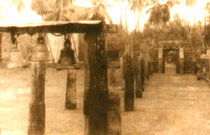 Apart
from very limited information, not much is known about the Ishwaram Temple
here, unlike the other Pancha Ishwaram temples. It is very likely the
"Ishwaram" Shivan Temple went out of function early; in such an event, the
local folks would have, however, "kept going" for their veneration, the
Vishnu section of the Ishwaram Temple complex. The bell, pillars and other
ruins there today may therefore be those of the last Vishnu temple
erected there.
Apart
from very limited information, not much is known about the Ishwaram Temple
here, unlike the other Pancha Ishwaram temples. It is very likely the
"Ishwaram" Shivan Temple went out of function early; in such an event, the
local folks would have, however, "kept going" for their veneration, the
Vishnu section of the Ishwaram Temple complex. The bell, pillars and other
ruins there today may therefore be those of the last Vishnu temple
erected there.
The Five ancient Ishwaram Temples
In this connection. it is relevant to quote, once again, the oft-quoted
declaration made by that erudite scholar and Historian Dr.Paul E.Pieris,
before the Royal Asiatic Society in 1917:
"Long before the arrival of vi Maya there was in Lanka five
recognised Ishwarams of Shiva which claimed and received adoration of
all India. These were Thiruketheeshwaram which was near Mahatittha,
Muneshwaram dominating Salawatte and the pearl fishery, Thondeshwaram
near Mantota, Thirukoneshwaram near the great Bay of Kottiyar and
Naguleshwaram near Kankesanturai".
Chandra Mauleswara Murthi
A map drawn by early Greek cartographers. found in a library reveal the
existence of an Ishwaran Temple here, the towers of which were a guide to
navigators. In that temple the principal deity was known as "Chandra Maul
Eshwaran". on the forehead of the deity was a large precious stone shaped
like a crescent.
The 17th century Temple
Portuguese writers refer to a temple here that their army entered and
destroyed. It is said that the temple top (probably the Vimanam) was
overlaid with golden plates, which reflected the sun, aiding navigators.
To spite the protests of sacrilege by the Brahmin Priests, it is said
that the army slaughtered a cow on the top of the main deity of the temple;
mention is also made of the 108 devadasis forming part of the temple staff.
All this indicates beyond any doubt the existence at the site of a
well-established and functional temple, during the 17th century.
Recent (1998) revelation of a Shiva Linga Hindu Deity, in the
South of Sri Lanka.
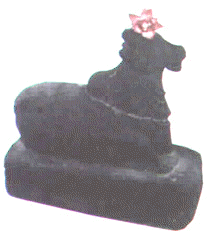 The
following news item appeared in the London popular weekly Journal
"Newslanka", of 5th November 1998:
The
following news item appeared in the London popular weekly Journal
"Newslanka", of 5th November 1998:
Thondeshwaram Nandi unearthed in Nov 1998 at Dondrahead "Shiva Linga"
found at Devinuwara A sculptured 'Shiva Linga' was found in the foreground
of t Othpilima Vihara in the historical Vichithrama Viharaya in Devinuwara.
"A person who was weeding the temple garden traced the sculpture. The
'Shiva Linga' is 4 ft in height and 2 1/2 feet in width. At an earlier
occasion too a similar sculpture was found at the same premises. It is
believed that these findings give a clue as to existence of a 'Shiva
Devalas at the premises in the past."
As Hindu Temples have not been known to have functioned in that region in
recent years, the unearthed Shiva Linga Murthi may obviously be a deity from
one of the Thondeshwaram Temples. As the Lingam is said to be comparatively
large in size, it could even be the principal Murthi of the ancient temple.
What have been unearthed are extremely interesting. The "avudaiyar" or
the pedestal of the Shiva Lingam appears to be a thin slab; the upright or
vertical portion is tall and slender. The "Nandhi" Ishapam appears to be of
coarse finish, showing lack of suitable implements. These can therefore said
to be of very ancient origin, probably of about the Pallava era.
If this Shiva Linga Moorthy, now unearthed, was indeed from the ancient
Thondeshwaram Temples then the event is a revelation, a major revelation!
Shruthi Laya Shangham of Great Britain has managed to acquire the photograph
of this lingam and is the first institute to publish it in 500 years.

Koneshwaram
[see also
Our Temple: Thirukoneswaram;
Trincomalee - Holy Hill of Siva
and
Welcome to Thirukoneswaram]

 Thiru
Koneshwaram, the "Dakshana Kailash" of the ancients, "The Great Pagoda" or
"The Pagoda with a thousand Pillars" of the Portuguese or simply Swami Rock"
during the British regime, is the most ancient place of Hindu veneration in
Ceylon. It has very interesting history behind it.
Thiru
Koneshwaram, the "Dakshana Kailash" of the ancients, "The Great Pagoda" or
"The Pagoda with a thousand Pillars" of the Portuguese or simply Swami Rock"
during the British regime, is the most ancient place of Hindu veneration in
Ceylon. It has very interesting history behind it.
The Great Deluge ("Piralayam" in Tamil) Koneshwaram Shrine
During the very early legendary eras, geologists refer to oceanic bed
upheavals or geophysical convulsion (Piralayam in Tamil), which are said to
have engulfed parts of Kumarikandam, in the region of the Indian Ocean. It
is believed to have occurred more than once, possibly three times.
Dakshana Kailash
During these upheavals and submergence, the region South of the
Thamparaparani River got severed and formed a rocky terrain with green paddy
fields, called the "Eela Thesam". During the convulsion, a three cornered
hillock (Tri-kona-malai) was uprooted and flung by the avalanche, and got
lodged along the NorthEast Coast of Eela Thesam.
As this "Trikonamalai" was surprisingly directly South of Mount Kailash
of the Himalayan Mountain range, it became known as "Dakshana Kailash" or
Kailash of the South.
In Puranic extravaganza. Lord Shiva, accompanied by the Devas, Rishies
and several others, is said to have taken his abode here on Trikonamalai and
restored calm weather. Originating thus, Dakshana Kailash or Thiru kona
malai soon became a holy place; as Shiva or Eshwaran took his abode here, it
is therefore an Eshwaram of the three-cornered hill or Thiru-Kon-Eshwaram,
or Koneshwaram.
Pallava Cultural Influence
The Pallava era saw a resurgence of Hindu religious devotion. Their
capitals Kanchipuram and Amaravathi were seats of learning and sculpture.
They excelled in sculpture and are remembered today for their temples in
stone architecture.
Their cultural influence spread to distant lands in South East Asia. It
became well established in medieval Ceylon, due to the friendly relationship
between the Rulers. Inspiring examples are yet to be seen at:
1. Remnants of ancient pillars at Koneshwaram
2. Isurumuniya Rock Temple, near Anuradhapura
3. Man and the Horse, rock sculpture
4. Elephants in the water, rock sculpture
5. Isurumuniya Lovers, rock sculpture, and the
6. Gedige Temple at Nalanda
Advent of Kulakoddan (436 A.C)
Chola Kankan, a Prince, arrived here on pilgrimage, in keeping with a
parental vow and found the temple all broken down. He immediately took steps
to rebuild the temple in magnificent Pallava architecture. He founded the
Papa Nasa Theertham and also built a large irrigation tank at Kantalai. He
invited forty Vanniya family clans from India, to cultivate the lands under
the tank and sustain the maintenance of the temple complex he had erected.
Posterity has crowned him with the epithet name of "Kulakkoddan" (Builder of
Tank and Temple). Lt. Col. C.P. Thomas, R.A. a modern administrator-author
writes, "A Prince came along, and hearing that the Rock of Trincomalee was a
fragment of The Golden Mountain of Meru hurled there during the conflict of
the Gods, erected on it a Temple for Shiva". Truly Kulakoddan was an
"Emissary" of the Lord and his advent was by Divine Grace.
Tamil Kings ruling at Anuradhapura
The Tamil Kings who reigned in ancient Anuradhapura sponsored Hindu
places of worship; they also made large endowments. The two landmarks of
Tamil Saiva literature "Kanda Puranam" and "Dakshana Kailasa Puranam" were
later composed; they were based on "Skanda Purana", a Sanskrit narrative of
the exploits of God Skanda Kumar, the Divine Youth.
Saiva Saint Thiru Gnana Sampanthar (circa 6th century A.C.)
The Saiva Saint Thiru Gnana Sampanthar, in his pilgrimage to Shiva
Sthalams, made his obeisance before Konainathar, and offered a garland
("pathikam") of precious Thevaram verses, in praise of the Lord who has
taken His abode at Kona-ma-malai.
The Chola Regime: The Golden Fra of Saivism (both - 12th
centuries)
During the golden period of the Chola regime, Hindu Saivaism reached its
zenith. In Ceylon, Hindu temples were erected wherever Hindus resided in
large numbers. Trincomalee region figured prominently at that time, due to
its proximity to the Indian continent. The magnificent Koneshwaram temple
and the adjacent region formed a great Principality under a Vanniya as
Governor. Residents in this collective community were allotted services,
which they had to perform at the Koneshwaram temple.
Jata Varma Pandyan 11(1263 A.C.) at Koneshwaram
The Pandyan co-Ruler defeated the King of Lanka and planted the Pandyan
Ensign, with the "Double Fish" emblem at Kona-ma-malai. The Ensign may be
seen today at the entrance to Fort Frederick.
The Sthala Puranam describes the location at that time as "Kona ma-malai,
around which the ocean waves swept pearls, gold, precious stones, and shells
from the depth of the ocean and heaped them along the shore"
The Temple was well supported by the local residents. A large Tamil stone
inscription of the thirteenth century, seen even today at Kankuveli village,
records the assignment of income from the rice fields and benefits from
other lands in the village, to Konanayakar of Kona -ma malai.
Ariya Chakravarthy Kings of Jaffna (1215 - 1620)
The Tamil Kings of Jaffna, paid homage at Koneshwaram, They offered gifts
of gold and silver. One of them, Jayaweera Singai Aryan Sega Raja Sekaram V
(1380-1410 A.C.), had the traditional history of the temple compiled as a
chronicle in verse, entitled "Dakshana Kailasa Puranam". That precious work
is accepted today as the Sthala Puranam of Koneshwaram Temple.Saint
Arunagiri Natha Swamikal (circa 1468) on his way to Kadirkamam, paid homage
here. This devotee and Bard of Sri Murukan (Skanda Kumaran) worshipped at
Koneshwaram and offered a garland of Thiru Pukal verses, in praise of the
Sthalam. "The population" he quoted, "at Koneshwaram, where the deep ocean
rolled its furious waves, was vast, the temple well organised and the
priests well versed in the "Four Vedas" - Thiru Pukal.
Koneshwaram in Mediaeval Splendour (1400-1500)
Large numbers of pilgrims visited the temple for venerating Lord
Konainathar and Mathumai Ambal. The name and fame of Koneshwaram spread far
and wide and gained high renown. "It was esteemed as one of the richest
temples in South East Asia, having in its possession much gold, pearls,
precious stones and silks endowed over thousand years". it was a veritable
treasure to tempt any marauding maritime power to covet its wealth.
The Portuguese in Ceylon
The Portuguese came to Ceylon in 1505 and soon embarked on their
"Temporal and Spiritual conquest of the Island". Soon after, many Hindu
Temples were looted and destroyed.
Koneshwaram Temple destroyed -1624
The much-valued Koneshwaram temple was first looted on Hindu New Year
Day, Friday the 14th of April 1624. Thereafter, Constantine de Sa razed the
temple structure to the ground, blasting some of it into the ocean (remnants
of which are being recovered even in the 1990's). In his dispatch to the
King of Portugal, Constantine described: "The land of the Pagoda is 600
fathoms long and 80 feet at its broadest, narrowing to 30 feet. Regarding
the prophetic inscription, he added. "When I went there to make this Fort, I
pound engraved on the Pagoda, among many other inscriptions, one that ran
thus: Kulakoddan has built this pagoda..."
A site plan of the temple area prepared by a Portuguese author states:
"On the first rise to the summit of the rock was a Pagoda, another at
mid-ascent, and the most famous of them all at the highest eminence."
With the stones recovered by blasting Koneshwaram temple, the Portuguese
erected a triangular fortress, on Kona-ma-malai, which was named "Pagoda
Hill" by them. The fortress lasted only a couple of years.
The British take Trincomalee.
The British captured the Fort, from the Dutch, after a six-day siege. The
Hindus at Kona-ma malai, with the permission of the British Military who
were in occu pation of the Fort recommenced restricted worship.
Frederick, Duke of York and son of King George lil, who occupied the Fort
as Commander of the Garrison, gave it the new designation of Fort Frederick,
by which name it continues to be known even today.
Worship on Swami Rock
Worship was then allowed from Swami Rock only on certain days. The
devotees gathered outside Fort Frederick and were escorted to Swami Rock;
when the rituals of an ad hoc pu ja were over, they were escorted out. But
the restrictions were soon relaxed.
Upsurge of Hinduism in the 1950s
With the restoration of the ancient Palavi Theertham at
Thiruketheeshwaram, there was an upsurge of Hinduism, all over the Island.
At Trincomalee, several vigrakams were unearthed while excavating a trench,
in 1950. These were taken in procession around the Island and finally
installed at Koneshwaram.
The temple structure that we see today at the site was soon commenced and
completed in 1963.

Naguleshwaram [see
also Naguleswaram
Temple Restoration]
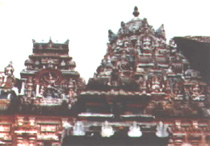 Keerimalai
Springs & Maviddapuram
Keerimalai
Springs & Maviddapuram
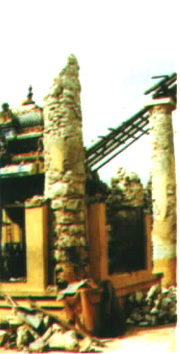 Naguleshwaram
(on the left as it was, and on the right, as it is today, after the
armed
conflict) was one of the celebrated ancient five Shiva
Sthalams known to have existed even before the Vijayan era. It was situated
on the northern seacoast of the Jaffna Peninsula, about three kilometres
west of Kankesanturai. The ancient temple is now no more, only a rocky cave
can now be seen at the site, about a kilometre east of Keerimalai. However,
the modern Shivan Kovil at Keerimalai, known as Naguleshwaram, perpetuates
the ancient name.
Naguleshwaram
(on the left as it was, and on the right, as it is today, after the
armed
conflict) was one of the celebrated ancient five Shiva
Sthalams known to have existed even before the Vijayan era. It was situated
on the northern seacoast of the Jaffna Peninsula, about three kilometres
west of Kankesanturai. The ancient temple is now no more, only a rocky cave
can now be seen at the site, about a kilometre east of Keerimalai. However,
the modern Shivan Kovil at Keerimalai, known as Naguleshwaram, perpetuates
the ancient name.
Nagula Munivar
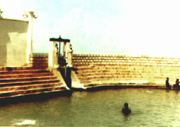 Keerimalai
is a well-known bathing ghat. Keeri means "Mongoose" and malai is a "hill";
hence literally, "The Mongoose Hill". Tradition has it that once a Munivar
spent his days performing tapas in a cave in these rocky hills and having
ablutionary baths in the waters of the springs.
Keerimalai
is a well-known bathing ghat. Keeri means "Mongoose" and malai is a "hill";
hence literally, "The Mongoose Hill". Tradition has it that once a Munivar
spent his days performing tapas in a cave in these rocky hills and having
ablutionary baths in the waters of the springs.
Due to his severe austerities, he gradually shrank physically, so much so
that he became referred to as Nagula Munivar (Nagula = a mongoose in
Sanskrit).
Eventually the rock also got the name of Nagula Giri (Giri =rock in
Sanskrit) The location became a sacred sthalam with the name of
Naguleshwaram. Thereafter, according to tradition and history, several
afflicted persons sought cure here, by having curative baths in the spring
waters of Nagula Giri (Sanskrit) or Keeri Malai (Tamil).
Maviddapuram and Kovil Kadavai
Maviddapuram is situated about a mile south of Kankesanturai. Kovil
Kadavai was the original name of the Maviddapuram region; it forms with
Naguleshwaram (Keerimalai) and Kasathurai (Kankesanturai), a celebrated
triangular region of ancient fame.
Marutha PiravikaValli
According to tradition thither came Chola Princess Marutha Piravika
Valli, daughter of Thissai Ukkira Cholan.
She was afflicted with a congenital disease, which affected her facial
appearance. All medical treatment having failed she took to pilgrimage to
sacred sthalams. Sage Shanthi Linga Munivar, pitying her plight
advised her to proceed to Keerimalai, near Kovil Kadavai, where the Lord of
Naguleshwaram was presiding and to perform daily theertham baths in the
sacred fresh water spring there.
Marutha Piravika.Valli at Kovil Kadavai
She arrived at Kovil Kadavai with her retinue of escorts and maids in
attendance and took up residence in proximity to the theertha sthalam, at a
locality, which even today is referred to as Kumarathi Pallam. Her daily
obeisance and the curative value of the medicinal waters of the fresh water
spring gradually helped her to rid of the facial horse-like affliction.
Her Resolve
In her daily journeys to the theertha sthalam, she noticed an old man by
the name of Sadaiyanar venerating with daily pu jas a silver Vel. the emblem
of God Skanda Kumaran, placed in a cove on a mango tree. she made a vow
then. she felt the divine urge to build a proper temple for housing the
deity and informed her father of her resolve. Very soon sthapathy architects
and craftsmen arrived from Chola Nadu and erected a magnificent Kandaswamy
Temple.
In due course, Maruthapiravika Valli married Ukkira Singan, a Kalinga
King (8th century) of Kathiramalai (Kanterodai) Jaffna. who had asked for
her hand.
New place Names
A Skanda Vigrakam "Kankeyan" was brought from India and landed at
Kasaturai (consequently the place assumed today's name of Kankesanturai). it
was installed with proper Kumba Abishekam ceremonies on ani-uthiram day in
the ninth century.
Priests, who came from India, Iooked after the affairs of the temple and
maintained it to a high standard. The name of the place was also changed
from Kovil Kadavai to Maviddapuram.

Shri S. Arumugam
Shruthi Laya Shangham gratefully acknowledges Shri Arumugam's
contribution in compiling the history of the five Shiva Sthalams of
ancient Ceylon.
Shri S. Arumugam was born in Nallur, Jaffna. He obtained a Science
Degree from the University College, Ceylon in 1928 and then proceeded to
Kings College, London, UK, where he obtained a Degree in Civil
Engineering in 1931. After graduating, he worked for the Manchester City
water supply works, and then returned to Sri Lanka in 1933 where he
joined the Irrigation Department and finally retired as Deputy Director
in 1965.
His work in the Irrigation Department required him to travel widely
in Sri Lanka, and this gave him the opportunity to study about the
ancient Hindu temples in all parts of the country. He has also studied
Hindu temples in India during his several visits. Apart from his
technical publications (he was President of the Institution of
Engineers, Sri Lanka) his published works connected with temples include
"Some Ancient Hindu Temples of Sri Lanka (1980), "The Lord of
Thiruketheeshwaram"(1981), "Thiru Koneshwaram" (1990), "Stone Scupitures
in Colombo Hindu Temple" (1990) etc.